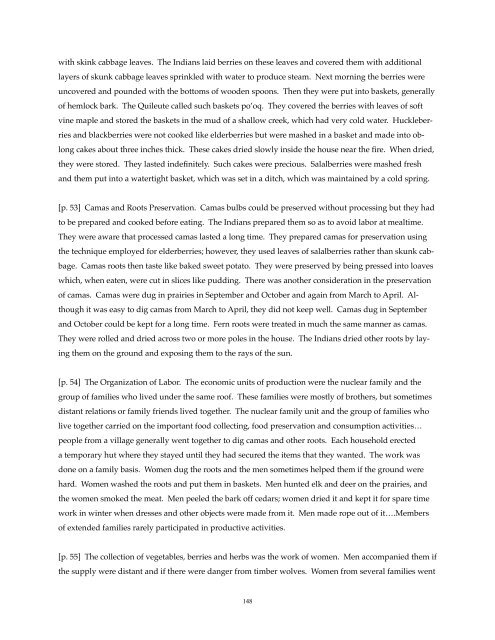The Ozette Prairies of Olympic National Park - Natural Resources ...
The Ozette Prairies of Olympic National Park - Natural Resources ...
The Ozette Prairies of Olympic National Park - Natural Resources ...
You also want an ePaper? Increase the reach of your titles
YUMPU automatically turns print PDFs into web optimized ePapers that Google loves.
with skink cabbage leaves. <strong>The</strong> Indians laid berries on these leaves and covered them with additional<br />
layers <strong>of</strong> skunk cabbage leaves sprinkled with water to produce steam. Next morning the berries were<br />
uncovered and pounded with the bottoms <strong>of</strong> wooden spoons. <strong>The</strong>n they were put into baskets, generally<br />
<strong>of</strong> hemlock bark. <strong>The</strong> Quileute called such baskets po’oq. <strong>The</strong>y covered the berries with leaves <strong>of</strong> s<strong>of</strong>t<br />
vine maple and stored the baskets in the mud <strong>of</strong> a shallow creek, which had very cold water. Huckleberries<br />
and blackberries were not cooked like elderberries but were mashed in a basket and made into oblong<br />
cakes about three inches thick. <strong>The</strong>se cakes dried slowly inside the house near the fire. When dried,<br />
they were stored. <strong>The</strong>y lasted indefinitely. Such cakes were precious. Salalberries were mashed fresh<br />
and them put into a watertight basket, which was set in a ditch, which was maintained by a cold spring.<br />
[p. 53] Camas and Roots Preservation. Camas bulbs could be preserved without processing but they had<br />
to be prepared and cooked before eating. <strong>The</strong> Indians prepared them so as to avoid labor at mealtime.<br />
<strong>The</strong>y were aware that processed camas lasted a long time. <strong>The</strong>y prepared camas for preservation using<br />
the technique employed for elderberries; however, they used leaves <strong>of</strong> salalberries rather than skunk cabbage.<br />
Camas roots then taste like baked sweet potato. <strong>The</strong>y were preserved by being pressed into loaves<br />
which, when eaten, were cut in slices like pudding. <strong>The</strong>re was another consideration in the preservation<br />
<strong>of</strong> camas. Camas were dug in prairies in September and October and again from March to April. Although<br />
it was easy to dig camas from March to April, they did not keep well. Camas dug in September<br />
and October could be kept for a long time. Fern roots were treated in much the same manner as camas.<br />
<strong>The</strong>y were rolled and dried across two or more poles in the house. <strong>The</strong> Indians dried other roots by laying<br />
them on the ground and exposing them to the rays <strong>of</strong> the sun.<br />
[p. 54] <strong>The</strong> Organization <strong>of</strong> Labor. <strong>The</strong> economic units <strong>of</strong> production were the nuclear family and the<br />
group <strong>of</strong> families who lived under the same ro<strong>of</strong>. <strong>The</strong>se families were mostly <strong>of</strong> brothers, but sometimes<br />
distant relations or family friends lived together. <strong>The</strong> nuclear family unit and the group <strong>of</strong> families who<br />
live together carried on the important food collecting, food preservation and consumption activities…<br />
people from a village generally went together to dig camas and other roots. Each household erected<br />
a temporary hut where they stayed until they had secured the items that they wanted. <strong>The</strong> work was<br />
done on a family basis. Women dug the roots and the men sometimes helped them if the ground were<br />
hard. Women washed the roots and put them in baskets. Men hunted elk and deer on the prairies, and<br />
the women smoked the meat. Men peeled the bark <strong>of</strong>f cedars; women dried it and kept it for spare time<br />
work in winter when dresses and other objects were made from it. Men made rope out <strong>of</strong> it….Members<br />
<strong>of</strong> extended families rarely participated in productive activities.<br />
[p. 55] <strong>The</strong> collection <strong>of</strong> vegetables, berries and herbs was the work <strong>of</strong> women. Men accompanied them if<br />
the supply were distant and if there were danger from timber wolves. Women from several families went<br />
148
















